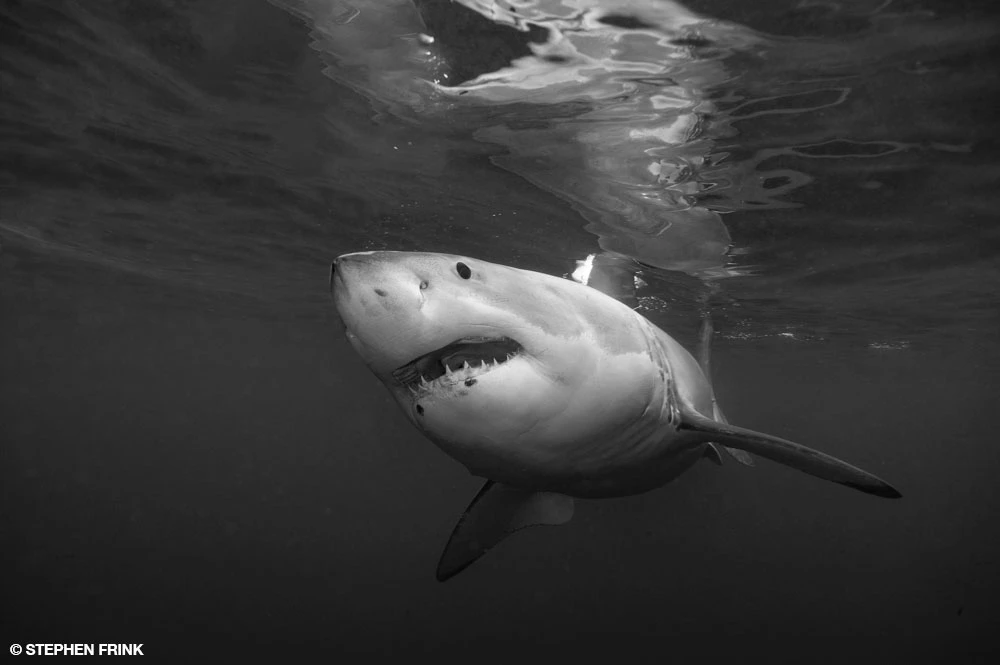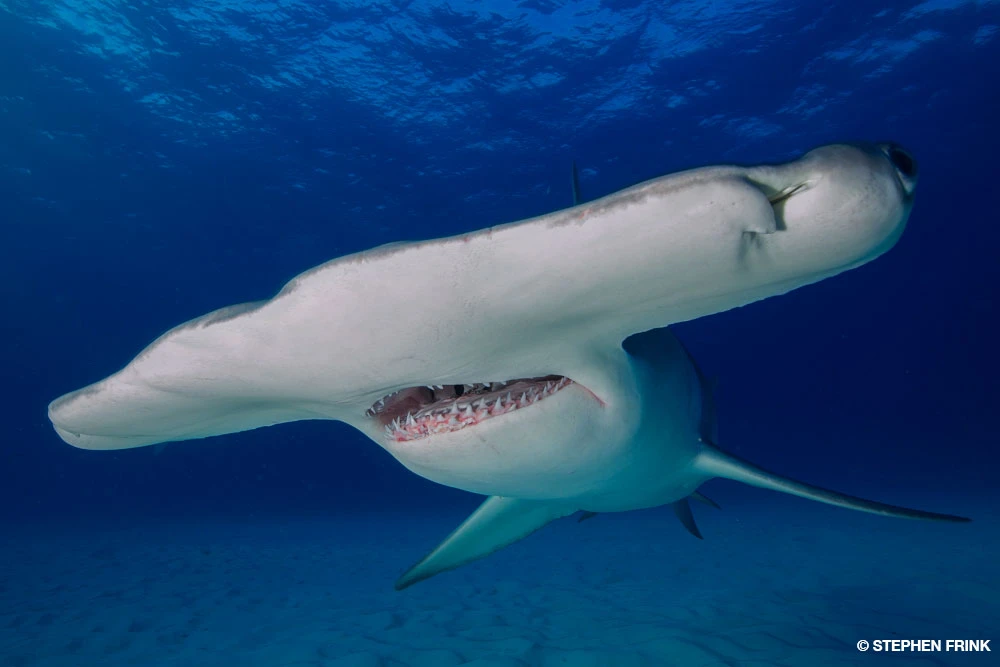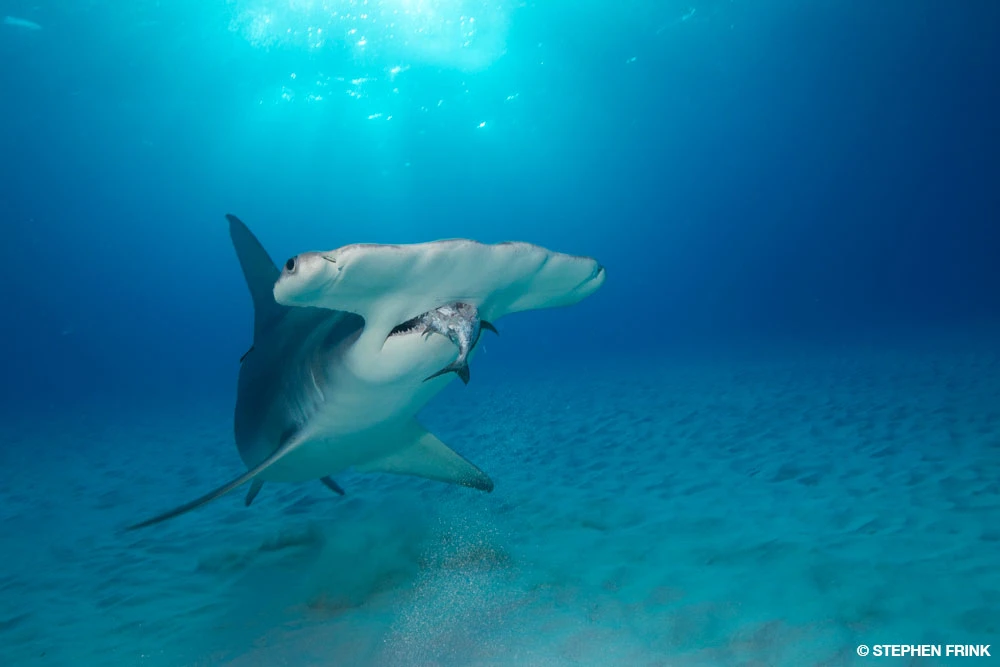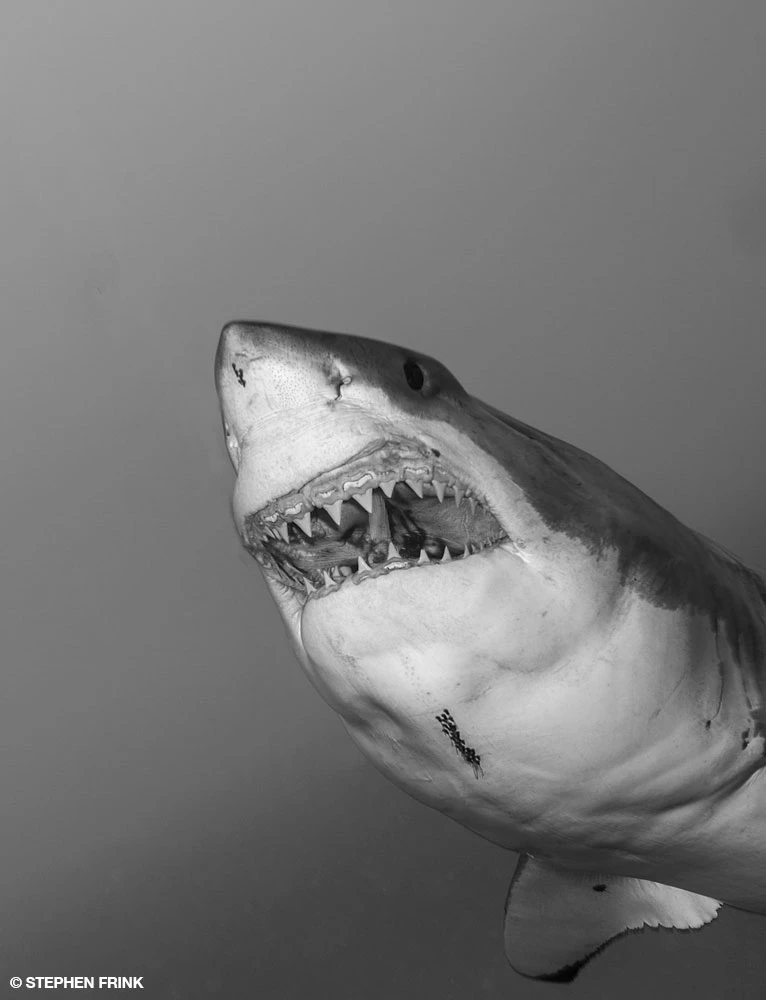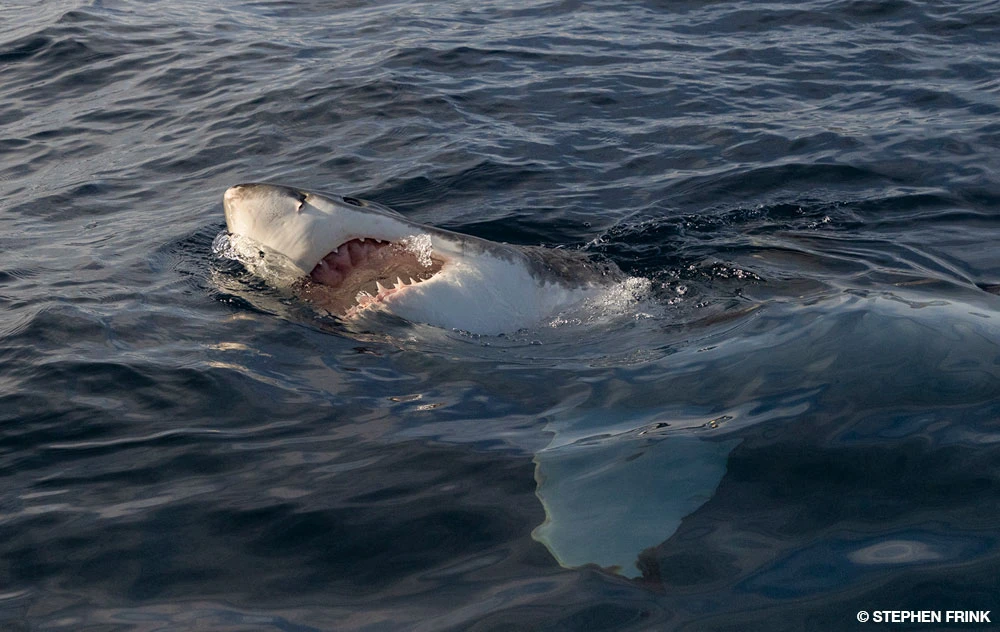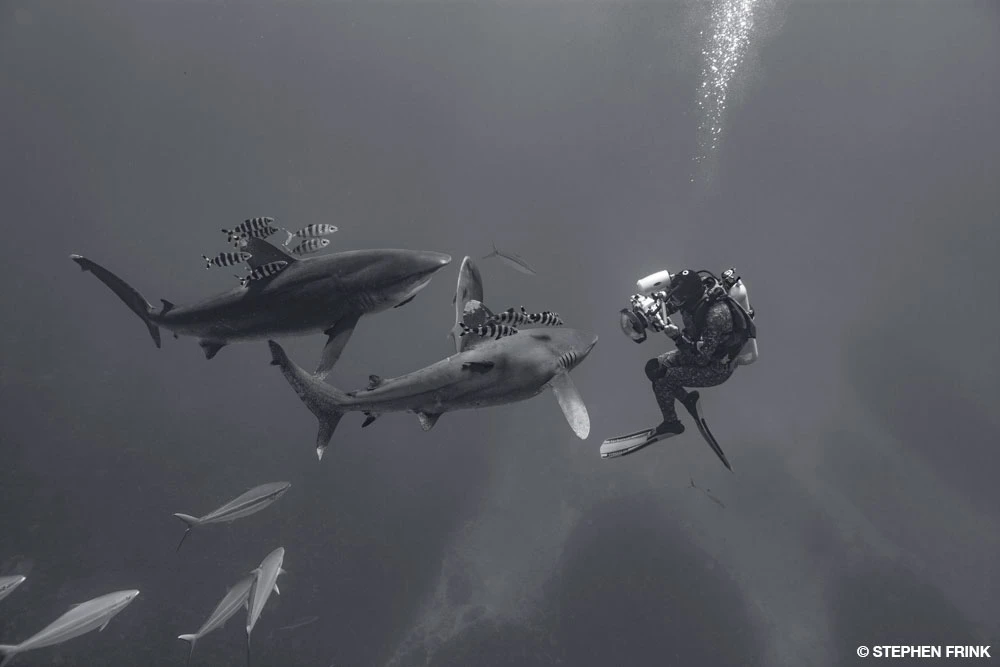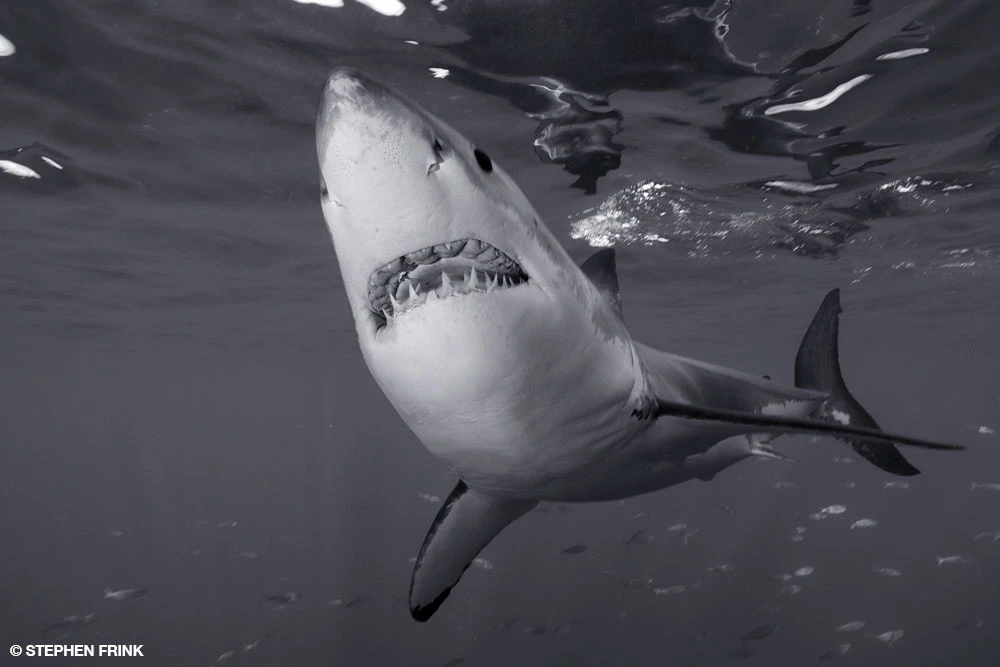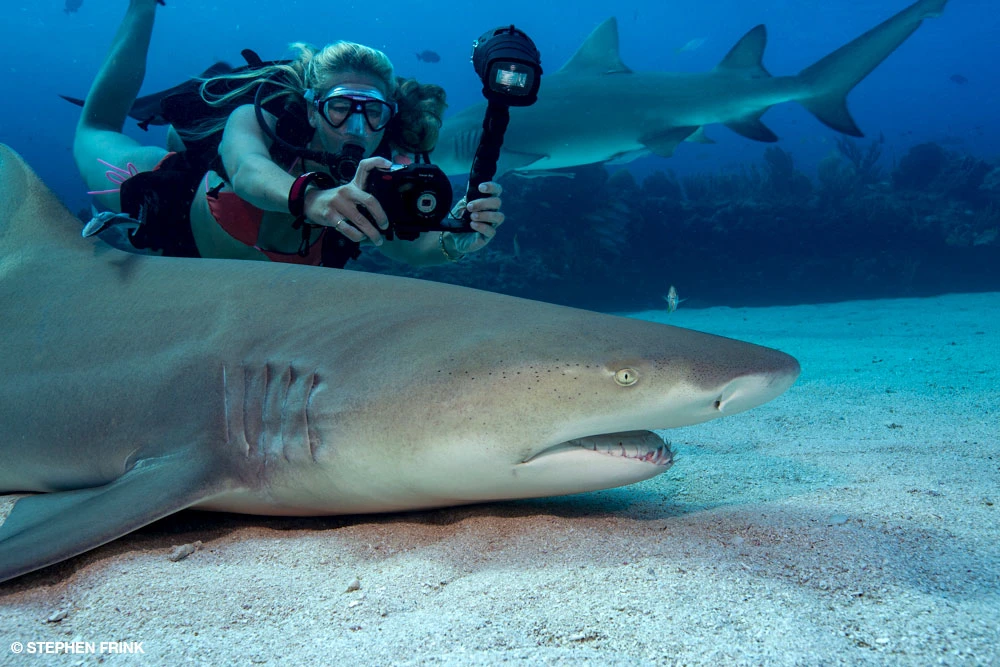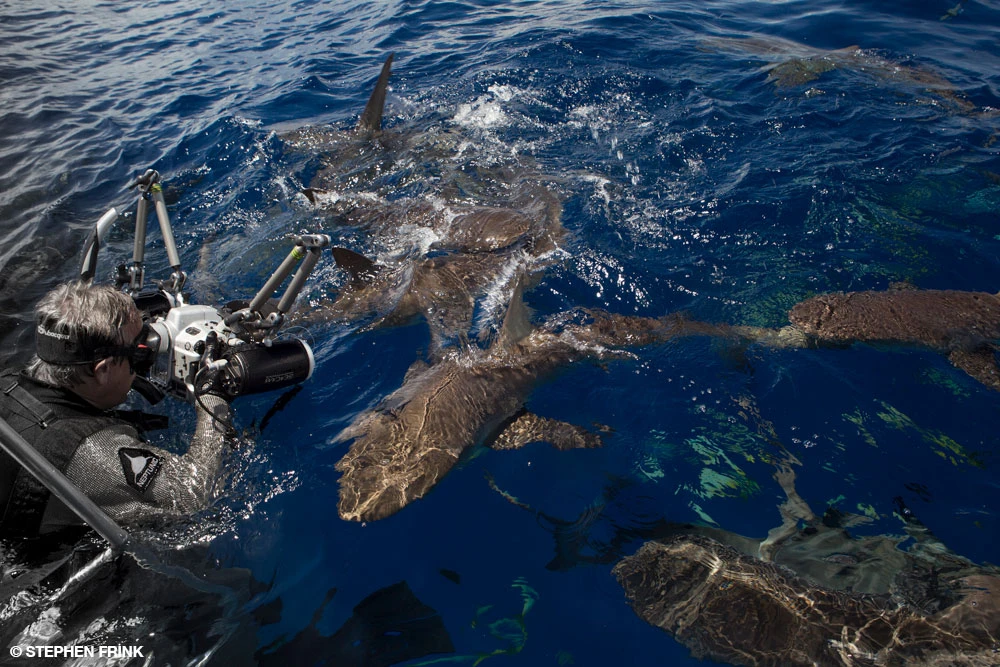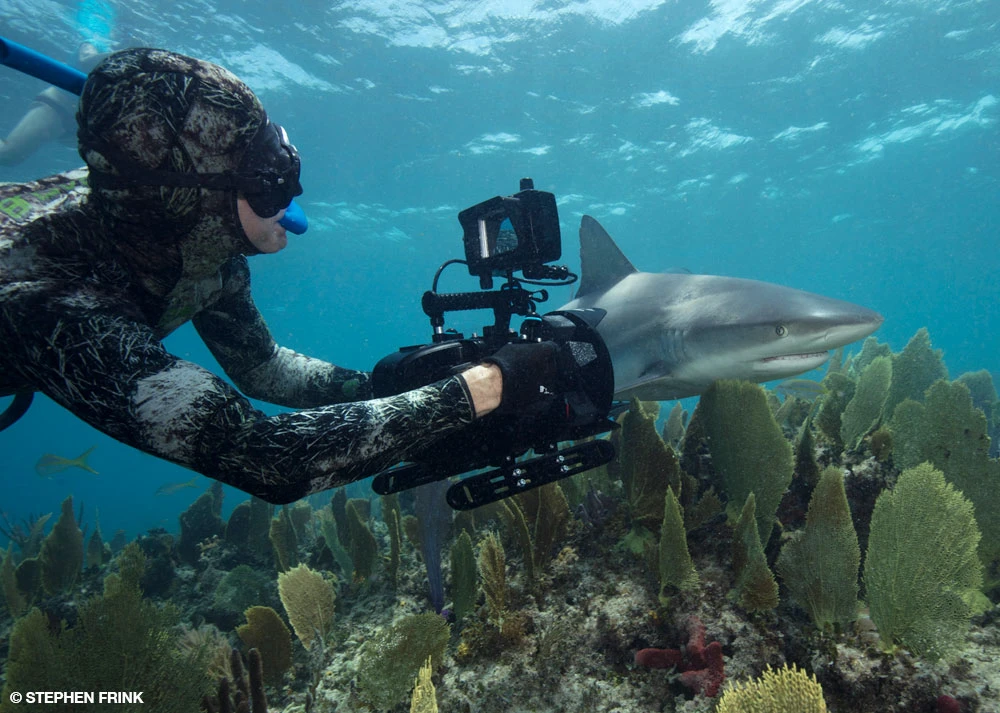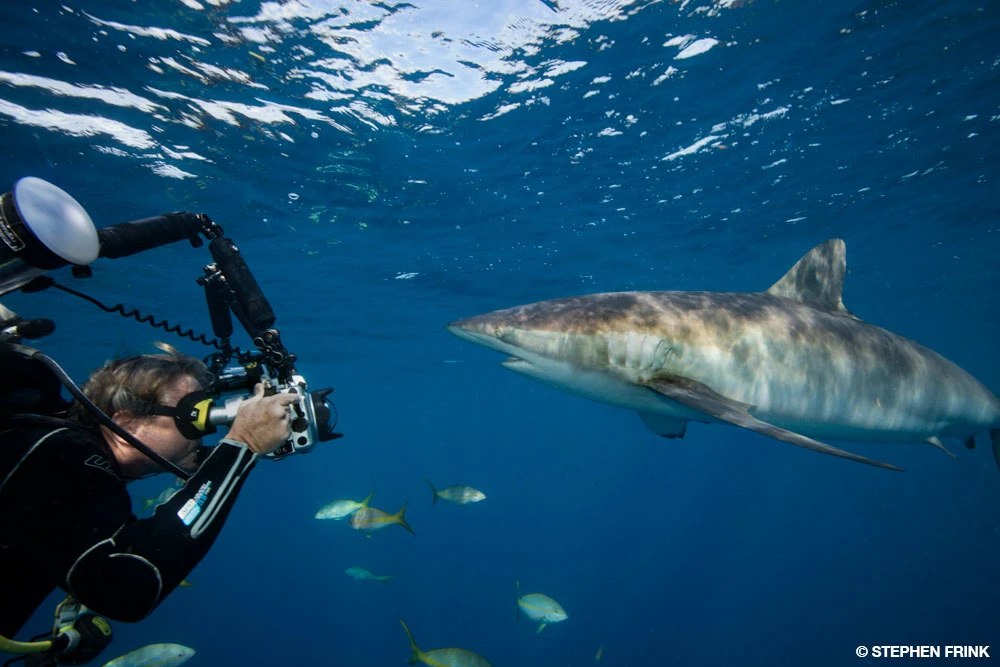Many divers seek interactions with sharks, but others actively seek to avoid them. As long as sharks are in the water, people will look for ways to reduce the lethality of a shark bite or decrease encounters altogether.
The development of shark deterrent devices over the years ranges from the head-scratching to the deranged: mobile self-propelled dive cages, reverse slurp guns that expend bait as a chum chaff countermeasure, shark cattle prods hooked up to battery backpacks, and even anti-shark grenades (patent US4155186A). Understanding the history of shark deterrents is important for appreciating modern innovations.
Bangsticks
Bangsticks have been around since the 1950s, and some of the original dive gear manufacturers sold them directly under their brand names. While lethal deterrents have fallen out of public favor, bangsticks for divers still exist and are produced by different manufacturers — although it’s rare to see a diver with one now.
They are simple in design, consisting of a pole with a chamber at the tip that holds a live round of ammunition over a fixed firing pin. Slam-firing the bangstick into the target forces the round back onto the pin and sets off the projectile. Both the projectile and expanding gas cause massive trauma and fatal tissue damage.
While bangsticks come in various lengths and virtually any caliber, the cartridges have to be waterproofed, as they are not designed to be submerged or subjected to the effects of pressure at depth. Bangsticks have a debilitating impact on sharks, but the user is not left unscathed. Using a bangstick at depth can damage your eardrums, and the pressure wave can be unpleasant, especially with large-caliber ammunition. The subsequent noise and gore can also attract more sharks and create a bigger problem than the original one.


Compressed-Gas Systems
The Shark Dart was designed in 1971 as a silent alternative to bangsticks and marketed as a defensive tool for divers to use only when in immediate danger of an attack. They were touted as “the most lethal anti-shark weapons in the world,” and true to the description, this compressed-gas injector weapon had terrifying results when hitting a shark in the correct target area.
The needle-tipped lance would penetrate the shark’s skin and actuate the cartridge-release mechanism, which made carbon dioxide gas rush into the shark’s body, rupturing and displacing the internal organs and forcing the shark to expel its entrails out through its mouth. The shark would then masticate its own innards while simultaneously suffering from rapid convulsions and an uncontrolled positive ascent. The Shark Dart came in different models but disappeared from the market after only a few years.
The concept was briefly revived in 2008 with the WASP Injection Knife. Designed to “reduce divers’ stress levels,” the WASP aimed to combine the precision of a knife with the stopping power of compressed gas. It worked similarly to the Shark Dart but with a button near the blade’s guard to be manually pressed to release the gas.

Nonlethal Deterrents
Compressed-gas weapons and bangsticks share the same shortcomings: dependency on visibility and requiring near-superhuman reflexes to use effectively underwater. Both devices fail with a glancing blow, and most divers don’t see the shark attack coming.
Today, killing sharks is highly controversial. Public perception toward sharks has changed from fearing them as man-eating maritime monsters to realizing their intrinsic value and important roles in marine ecosystems. Most people now believe shark bite incidents are accidental rather than intentional, but shark bite fatalities continue to occur around the world.
The effects of removing sharks from our oceans can be economically and ecologically damaging, and this understanding has given rise to nonlethal shark deterrents as alternative solutions. Several concepts exist behind the currently available personal protective shark deterrent devices divers can wear or deploy.
Chemical Repellants
Sharks have an impressive olfactory system and are highly sensitive to smell. Manipulating this sensory system is a longstanding area of shark deterrent development. The anecdote that sharks will avoid areas containing their decomposing brethren has been propagated by fishermen for hundreds of years.
The U.S. Navy developed the first chemical shark repellent, known as Shark Chaser, during World War II. It was made of a copper acetate and nigrosine dye mixture and designed to smell like decaying shark carcasses. The repellant was issued to U.S. military personnel from 1945 through the early 1970s until reports of its ineffectiveness led to its eventual removal from general issue.

Independent companies have continued to develop chemical deterrents using a myriad of concoctions, including irritants, vinegar, sulfur, peppers, pine oil, nicotine, and highly toxic compounds. Dispersal methods include chum blocks, underwater aerosol spray cans, squirt bottles, dissolvable packets, gels, pastes, and beads. Some products contained sharp aluminum flake particles designed to suspend in the water and get into the shark’s eyes, mouth, and gills. The concepts of sewing bite-released chemical pouches into swimsuits or mixing them into suntan lotions were also pursued.
Attempts have been made to harvest chemical defense mechanisms from various marine animals, but obtaining sufficient quantities, synthetically recreating the secretions, and extending their poor shelf life have been consistent logistical hurdles.
Work has continued based on the theory that dead sharks can repel living ones using necromones extracted from liquefied rotting shark tissue. While experimental tests have temporarily dispersed certain shark species, criticisms of this deterrent type are that some sharks exhibit cannibalistic behavior and that sourcing dead sharks is not commercially feasible and counterintuitive to conservation efforts.
Visual Methods
Shark species have varying degrees of visual acuity for detecting movement and contrasting colors. Blue, camouflage-patterned wetsuits attempt to make a diver blend into the surrounding water by breaking up their silhouette. Black- and white-banded divewear designed to emulate the natural patterns of pilot fish and poisonous sea snakes has been around since the 1970s, and full suits, rash guards, and limb sleeves move in and out of popularity and availability. These patterns’ warning effects may work on some species but could be limiting to others. Tiger sharks, for example, are a major predator of sea snakes.
Acoustic Deterrents
Sharks have an acute sense of hearing and can track sounds with considerable accuracy. Acoustic methods for modifying marine animals’ behavior are appealing since sound stimuli can propagate much farther underwater than any chemical, electrical, or visual method.
Acoustic deterrent devices for divers include wearable, battery-powered speaker units that emit propriety sound signals, including recorded orca sounds. Certain underwater sounds can alter a shark’s behavior and potentially deter it from entering an area. Artificial sounds outside a shark’s normal soundscape, however, may trigger investigative behavior in some species. More consideration and study are necessary to understand the impact of acoustic deterrents on other marine life.
Protective Wear
The concept of protective wear for shark bites has been around since recreational diving’s early days. Some dive suit designs offered pufferfish-style spiked armored suits as a potential method of preventing bites. These suits had as much chance of harming the user as protecting them and quickly became obsolete.
The focus shifted to fabric materials that would best minimize injury to the wearer. Neoprene with Kevlar ideally reduces the size and number of punctures of a shark bite, and wetsuits using proprietary polymer fiber technology combine protection and flexibility. Suits made of stainless-steel chainmail mesh act as a strong protective layer between diver and shark but cannot fully guarantee diver safety.

Electrosensory and Magnetic Deterrents
Sharks have a complex electrosensory system of specialized receptors called the ampullae of Lorenzini. These tiny gel-filled sacs on a shark’s head and snout enable it to passively detect bioelectric stimuli produced by potential prey, predators, and other sharks of the same species. Sharks use this sensory apparatus for attraction and avoidance. Species that rely heavily on this sense have many electroreceptors, while those that don’t typically have fewer.
The following deterrents attempt to saturate that sensory system with short but intense stimulation while having minimal or no effect on nontarget species without these receptors. The ampullae of Lorenzini can detect only small electrical and magnetic fields at very short distances. These fields dissipate quickly in water, so the effectiveness of these types of deterrents require the shark to be in very close proximity to have any effect.
Electrical: Electric shark deterrents work by creating an electrical field that surrounds the user. Once the shark detects the field through its sensory receptors, it is believed to cause mild discomfort and muscular spasms in the ampullae of Lorenzini, resulting in avoidance behavior.
For an electrical deterrent to work, the diver must position the device according to the manufacturer’s placement specifications, power it on, and have a sufficiently charged battery. Specific electric field characteristics, such as voltage gradient and frequency, are the key factors that influence how an electric deterrent will affect a shark’s behavior.
Several electric deterrents are available to the public, all of which the manufacturers claim are successful, but independent testing has shown that not all have the same level of effectiveness. While some of these deterrents have constantly emitting electrodes that create a three-dimensional electrical field around the wearer, others are pulse devices that have a considerable time delay between voltage pulses.
Magnetic: Several shark species have demonstrated the ability to sense magnetic fields. The Earth’s geomagnetic field is thought to help sharks orient themselves and navigate the world’s oceans. Some deterrents use powerful magnetic technology to create an electromagnetic field around the user.
Magnetic waves from the deterrent field are hypothesized to disrupt the shark’s electroreceptors and have a repellant effect. These devices require no batteries or charging, and the field generated by the magnet is always on.
Due to the magnets’ strength, they can potentially disrupt sensitive equipment such as memory cards, hard drives, compasses, and dive computers if placed in close proximity. Divers with magnetically affected medical devices should consult with their doctor and the device manufacturer before using this type of deterrent.
Electrochemical: Electropositive metals undergo hydrolysis and produce a measurable voltage when immersed in seawater. The charge distribution is thought to take advantage of a shark’s sensitivity to voltage gradients by overwhelming its electrosensory system, and the localized change in the water’s pH balance may act as an irritant.
These devices don’t need external power, and the repellant effect can last up to 48 hours depending on the type and thickness of the alloy or metal used. The metal is lost due to corrosion during the chemical reaction, so divers will need to replace the device after using it.
Conclusion
There are reports of attacks and fatalities to victims using different types of deterrent devices. Using a deterrent device may provide you with peace of mind while diving, but no deterrent is 100% effective.
Shark behavior can be generalized, but individual motivation — be it genuine hunger or simple curiosity — is a strong factor in a shark’s determination to power through deterrents. Don’t allow an increased perception of personal safety from the use of a deterrent cause you take risks you normally wouldn’t.
Explore More
While this article is about shark deterrents, some divers prefer to get close to sharks. Stephen Frink presents a bonus photo gallery of some of his favorite shark images. You can also learn about some recent shark deterrent research in these videos.

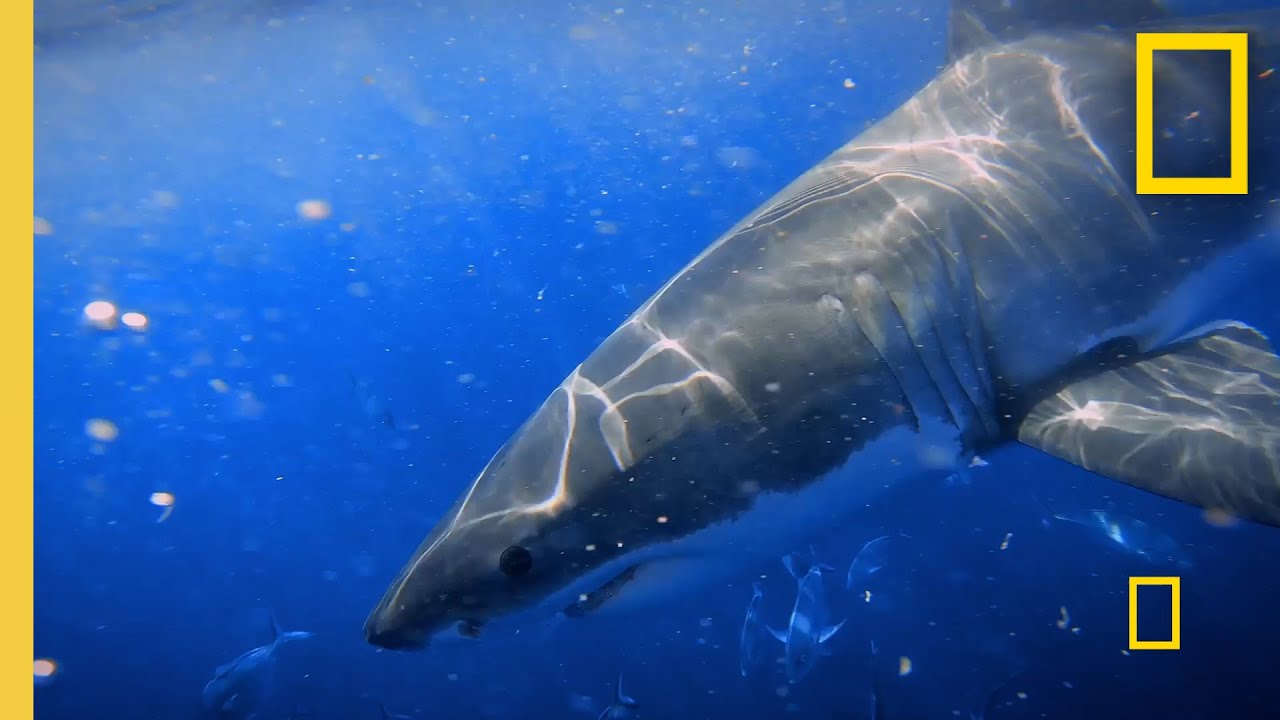
© Alert Diver – Q3 2024
